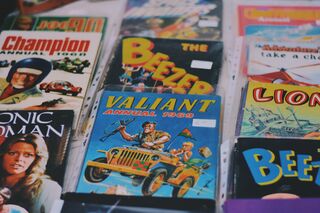Intelligence
How to Cite Comic Books and Graphic Novels in APA Style
When the style manual neglects comics, how do you cite them in APA-style works?
Posted August 2, 2021 Reviewed by Davia Sills

When this blog previously explained our popular culture psychology books' cheats on APA style, the post noted, "Because APA style does not remotely suit how people read, organize, and think of comic books and graphic novels, we cite comics so differently that I will not elaborate on them here at this time." Writers keep asking for guidance on that issue because some need to cite comic book publications, though, so it is still worth addressing.
The books that I write and edit list comic books and graphic novels as a separate reference list that appears before APA-styled "Other References." In the comics list, items fit the way readers and comic book professionals think about those publications.
- Action Comics #1 (1938, June). "Superman, Champion of the Oppressed." Script: J. Siegel. Art: J. Shuster. DC Comics.
- The Avengers #4 (1964, March). "Captain America Lives Again!" Script: S. Lee. Art: J. Kirby & G. Roussos. Marvel Comics.
- Batman: The Killing Joke (1988). Script: A. Moore. Art: B. Bolland. Marvel Comics.
They follow this basic structure:
- Series or graphic novel title, issue number if any (year, month/season if identified). "Story title if any." Script: Writer(s). Art: Penciller(s), inker(s). [Eventually, we stopped including month because it added nothing that would help readers find a specific story.]
How does this adapt when we must adhere to APA style? Easy Bib (n.d.) says, "To cite a comic book in print in APA, follow this format":
- Author’s Last name, First initial. Middle initial. (Year published). Title of comic book issue [Cartoon]. City of publisher, State or Country of Publisher: Name of publisher.
- Azzarello, B. (2011). Wonder Woman [Cartoon]. New York, NY: DC Comics.
Do not do that for three reasons: (1) A comic book story is a creation of writer(s) and artists(s) working together. Do not neglect the artists; (2) A comic book is not an animated cartoon, as the term cartoon is more commonly understood; (3) The format and example have left out the issue number and therefore fail to identify the correct story. Brian Azzarello authored two issues of Wonder Woman that had 2011 cover dates, #1 and #2. (Plus, APA style no longer requires location.)
We could reference a graphic novel the way we list a book (Becker, 2015) and then a comic book story the way we'd list an article in a regular magazine. Comic books are comic magazines, after all, despite the term comic book. (Most are not comical these days, either.)
- Moore, A. (1986). Batman: The killing joke. DC Comics.
- Azzarello, B. (2011). Home. Wonder Woman, 4(2). DC Comics.
In-text citations for these examples would cite Moore (1986) for the graphic novel and Azzarello (2011) for the comic book story. Depending on where you disseminate your own work, that may suffice. These references may be optimal when submitting to a publication that strictly requires APA style because APA style does not require recognition for illustrators. And yet comic book fans may curse you for ignoring illustrators. The APA style blog's method for citing an illustrated book may suit a graphic novel (APA Style, 2020).
- Moore, A. (1986). Batman: The killing joke (B. Bolland, Illus.). DC Comics.
A comic book story is not prose, though. The illustrators are the writers' collaborators and co-creators in many ways. Whether the writer provides a tightly detailed script or dumps only a loose notion that barely passes for plot, the illustrator brings it to life. When movie directors receive more attention than screenwriters do, comic book artists should receive no less credit than do the writers. Crediting artists as co-authors may be the way to go.
- Moore, A., & Bolland, B. (1986). Batman: The killing joke. DC Comics.
- Azzarello, B., & Chiang, C. (2011). Home. Wonder Woman, 4(2). DC Comics.
Unlike the examples above, the majority of comic book stories get illustrated by more than one artist. If so, credit the penciller(s) and then the inker(s) as is the norm for comic book publications. Parenthetical credits can distinguish writers from artists when you are free to borrow from other manuals of style.
- Moore, A. (writer), & Bolland, B. (artist). Batman: The killing joke. DC Comics.
- Moore, A. (script), & Bolland, B. (art). Batman: The killing joke. DC Comics.
- Lee, S. (writer), Kirby, J. (penciller), & Roussos, G. (inker). (1964). Captain America lives again! The Avengers, 1(4). Marvel Comics.
- Lee. S. (w), Kirby, J. (p), & Roussos, G. (i). (1964). Captain America lives again! The Avengers, 1(4). Marvel Comics.
One problem lingers: Those comic book stories did not really have volume numbers. DC and Marvel Comics do not number the volumes when rebooting existing series or reviving canceled ones. Fans impose volume numbers, which sometimes helps but sometimes confuses everybody. Even though comic book publications sometimes refer to those volume numbers, the publication information in each issue's indicia normally indicates no volume.
Here (as with any of it, to be honest), decide for yourself whether to identify volumes. Cover dates will almost always distinguish comics that share identical issue numbers. Admittedly, rare exceptions do occur, such as when Batman: The Dark Knight had two #1 issues both cover-dated in 2011 and Squirrel Girl did likewise in 2015, so either include the months or simply try not to cite Batman: The Dark Knight #1 (despite depictions of psychological conflicts) or Squirrel Girl #1.
Note: Thanks go to psychologist Eric Wesselmann, who simply wondered how to cite comics in APA style, and then I just kept thinking about it.
References
Related Posts
— Writing about the Psychology of Characters Under Copyright
— Psych Write: Feel the Music But Try Not to Quote It
— Psych Write: Anonymity vs. Accountability Using Pseudonyms
— Psych Write: Our Cheats on APA Style in the Reference List
APA Style (2020, February). Children's book or other illustrated book reference. American Psychological Association. https://apastyle.apa.org/style-grammar-guidelines/references/examples/c…
Becker, D. (2015, March 17). How to cite an illustrated book. APA style blog. https://blog.apastyle.org/apastyle/2015/03/how-to-cite-an-llustrated-bo…
EasyBib (n.d.). How to cite a comic book in APA, MLA, or Chicago. EasyBib. https://www.easybib.com/guides/citation-guides/how-do-i-cite-a/how-to-c…
Langley, T. (2018, August 1). Psych write: Our cheats on APA style in the reference list. Psychology Today. https://www.psychologytoday.com/us/blog/beyond-heroes-and-villains/2018…




